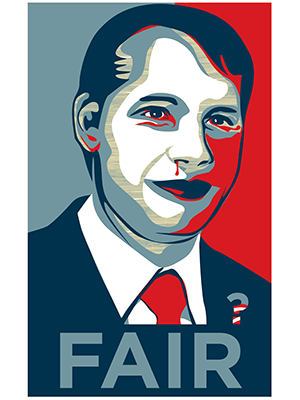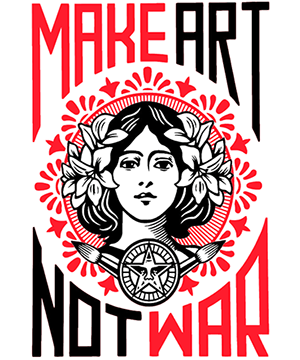Guerrillero Heroico (‘Heroic Guerrilla’) is an iconic photo of Marxist revolutionary Che Guevara taken by Alberto Korda. It was taken on March 5, 1960, in Havana, Cuba, at a memorial service for victims of the La Coubre explosion and by the end of the 1960s turned the charismatic and controversial leader into a cultural icon. Korda has said that at the moment he shot the picture, he was drawn to Guevara’s facial expression, which showed ‘absolute implacability’ as well as anger and pain. Guevara was 31 at the time the photo was taken.
Versions of it have been painted, printed, digitized, embroidered, tattooed, silk-screened, sculpted or sketched on nearly every surface imaginable, leading the Victoria and Albert Museum to say that the photo has been reproduced more than any other image in photography.
Guerrillero Heroico
Shepard Fairey
Shepard Fairey (b. 1970) is a contemporary artist, graphic designer, and illustrator who emerged from the American skateboarding scene. He first became known for his ‘André the Giant Has a Posse’ (…OBEY…) sticker campaign, in which he appropriated images from the comedic supermarket tabloid ‘Weekly World News.’ His work became more widely known in the 2008 U.S. presidential election, specifically his Barack Obama ‘HOPE’ poster.
Fairey’s first art museum exhibition, titled ‘Supply & Demand’ like his earlier book, was in Boston at the Institute of Contemporary Art in the summer of 2009. The exhibition featured over 250 works in a wide variety of media: screen prints, stencils, stickers, rubylith illustrations, collages, and works on wood, metal and canvas. As a complement to the ICA exhibition, Fairey created public art works around Boston. The artist explains his driving motivation: ‘The real message behind most of my work is ‘question everything.”
read more »
Andre the Giant Has a Posse
Andre the Giant Has a Posse is a street art campaign based on a design by Shepard Fairey created in 1989 in Providence, Rhode Island. Distributed by the skater community, the Andre stickers began showing up in many cities across the U.S. Over time the artwork has been reused in a number of ways and spread worldwide, following in the footsteps of World War II icon ‘Kilroy Was Here.’
Threat of a lawsuit from Titan Sports, Inc. in 1994 spurred Fairey to stop using the trademarked name ‘André the Giant,’ and to create a more styled image of the wrestler’s face, now most often with the equally iconic branding OBEY.
read more »
They Live
They Live is a 1988 film directed by John Carpenter, who also wrote the screenplay under the pseudonym Frank Armitage. The film is based on Ray Nelson’s 1963 short story ‘Eight O’Clock in the Morning.’ Part science fiction horror and part dark comedy, the film echoed contemporary fears of a declining economy, within a culture of greed and conspicuous consumption common among Americans in the 1980s.
In They Live, the ruling class within the moneyed elite are in fact aliens managing human social affairs through the use of a signal on top of the TV broadcast that is concealing their appearance and subliminal messages in mass media. The story revolves around a nameless man referred to as Nada (Roddy Piper), a quiet drifter who finds an unusual pair of sunglasses that allow him to see the aliens and their subliminal messages.
Heiligenschein
Heiligenschein [hahy-li-guhn-shahyn] (German for ‘aureola,’ literally ‘Holy shine’) is an optical phenomenon which creates a bright spot around the shadow of the viewer’s head. It is created when the surface on which the shadow falls has special optical characteristics. Dewy grass is known to exhibit these characteristics, and creates a heiligenschein. Nearly spherical dew droplets act as lenses to focus the light on the surface beneath them. Some of this light ‘backscatters’ in the direction of the sunlight as it passes back through the dew droplet. This makes the antisolar point appear the brightest.
The opposition effect creates a similar halo effect, a bright spot of light around the viewer’s head when the viewer is looking in the opposite direction of the sun, but is instead caused by shadows being hidden by the objects casting them. When viewing the Heiligenschein, there are no colored rings around the shadow of the observer, as in the case of a glory. In the 2006 Scripps National Spelling Bee, this was the word which eliminated crowd and national favorite Rajiv Tarigopula and elicited the audience to give him a standing ovation for receiving 4th place for the second consecutive year in a show of immense respect.
Déjà Vu
Déjà vu (‘already seen’) is the experience of feeling sure that one has already witnessed or experienced a current situation, even though the exact circumstances of the previous encounter are uncertain and were perhaps imagined. The term was coined by a French psychic researcher, Émile Boirac (1851–1917). The experience of déjà vu is usually accompanied by a compelling sense of familiarity, and also a sense of eeriness or strangeness.
It is difficult to evoke the déjà vu experience in laboratory settings, therefore making it a subject of few empirical studies. Certain researchers claim to have found ways to recreate this sensation using hypnosis. Déjà vu is is thought to be an anomaly of memory. In particular, it may result from an overlap between the neurological systems responsible for short-term memory and those responsible for long-term memory (events which are perceived as being in the past). The events would be stored into memory before the conscious part of the brain even receives the information and processes it.
Osteopathy
Osteopathy [os-tee-op-uh-thee] or osteopathic medicine is an approach to healthcare that emphasizes the role of the musculoskeletal system in health and disease. The first school of Osteopathy was founded in 1892 by Andrew Taylor Still, an Army surgeon in the American Civil War. In the United States an American-trained D.O. (Doctor of Osteopathic Medicine) is legally and professionally equivalent to an M.D. in all 50 states, since their medical education and training is mostly identical.
read more »
Tower Optical
Tower Optical is a small, Connecticut-based company which has manufactured a binocular tower viewer used at major tourist sites in the United States and Canada since 1932. The company’s large, silver-colored devices are used at Niagara Falls, the Empire State Building, the Golden Gate Bridge and other locations. Only about 35 of the viewers are manufactured each year, but several thousand are maintained by the company. Tower Optical has various arrangements with owners of the sites where the devices are located. Where the viewers are free, they are leased; at other locations, revenue is shared between the company and the site owner.
Each machine can hold up to 2,000 quarters, and earns somewhere between $1,200 and $10,000 per year. The company was founded by Towers S. Hamilton in 1933 in his Norwalk machine shop. His son, Towers W. Hamilton, later became the owner. His wife, Gladys (Kip) Hamilton, worked with him in the business for many years and on his death in 1989, she took over the company. She died in 2006, and at some point she passed the business on to her daughter, Bonnie Rising, who still owned the company as of 2010, when she had six employees, including her son, Gregory, and her husband, Douglas.










